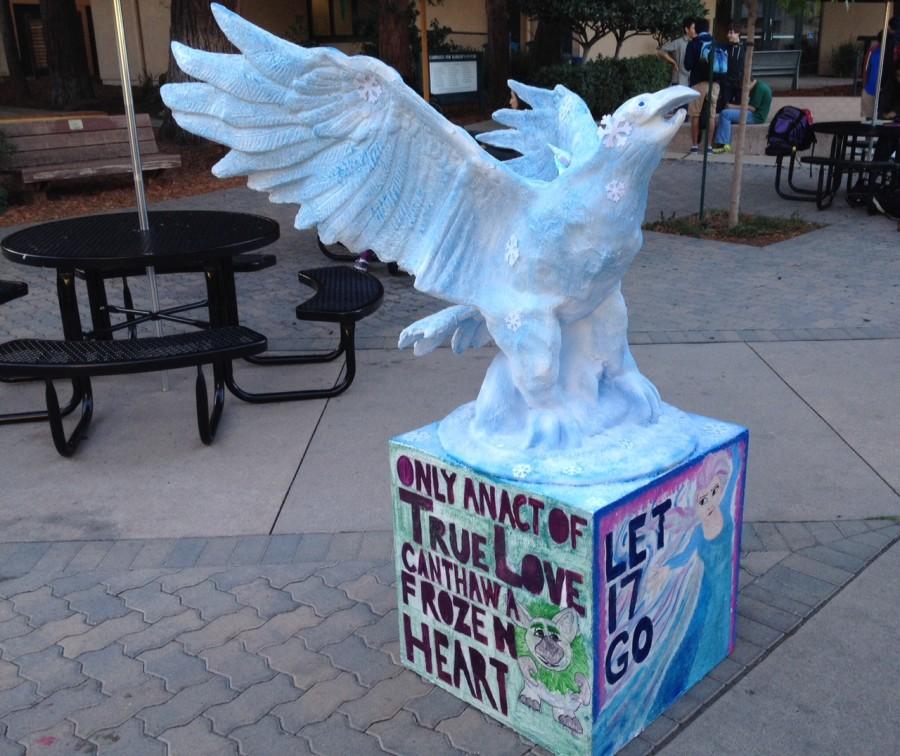Campus Compass: Painting Homecoming eagles
The sophomore Class of 2017 eagle stands in front of the journalism room. “It allows a group of students who are often not as gregarious and outgoing … to have different ways of showing spirit, and that’s my favorite aspect of it,” Jeffrey Draper, freshman class dean and performing arts teacher at the upper school, said.
October 16, 2020
Laughter and overlapping voices fill Manzanita and the quad as students chat with friends while eating lunch. Four majestic, bright white eagles stand on tarp in a straight line in front of the round tables with brightly colored paints and paintbrushes scattered around each one. A number of students gather around each eagle, exchanging ideas, lifting paintbrushes and laughing, and by the time the bell chimes signaling the end of lunch, each eagle displays a variety of unique colors and designs.
The tradition of painting eagle statues to celebrate Homecoming is something that many students look forward to as a way to bond with other members of their class and contribute to a friendly spirit competition. Initially, students at Harker celebrated Homecoming with stationary floats and displays.
However, Chris Daren, the activities director at the time, developed the idea of painting eagles, and the deans were involved as well. Soon, Harker bought four eagle statues. The reasoning for this also included efforts to support the environment and curb wastefulness. Thus the tradition began around 15 years ago and still lasts to this day.
“It allows a group of students who are often not as gregarious and outgoing … to have different ways of showing spirit, and that’s my favorite aspect of it,” Jeffrey Draper, freshman class dean and performing arts teacher at the upper school, said. “It allows everyone to feel included and it’s a great opportunity for students who are not going to be dressing up in silly costumes and going crazy that week to be a part of Homecoming in their way and to add something beautiful to the campus for the year.”
In addition, the eagle statues that are currently in use for this tradition are the exact same statues that students painted when this tradition first started. A coat of white paint is painted over the eagles after the competition so that students can participate in this Homecoming celebration the following year.
“The eagle is kind of like a redwood tree … If you were to look at a redwood tree’s stump, you can count the rings back and see different stories of that year of the tree’s life.” Eric Kallbrier, Director of Student Organizations and Assistant US Activities Coordinator, said. “If you were to cut down through the eagle, you would see … different layers of paint for every single year that students have painted it, … [and] you would see the history of [The] Harker Upper School.”
While the eagle statues may need to be replaced soon, the fact that they have lasted ever since the start has an impact on the students who participate in this tradition.
“It’s sort of like a time capsule too because you get to look back at all the previous classes and who won this, and how their eagle looked too, so it’s a very memorable and unifying experience,” Austina Xu (10), a student who contributed to the Class of 2023 eagle last year, said.
The tradition of painting eagles also constitutes a spirit competition between the classes at the Upper School, and each class receives points based on the ranking of their eagle. With students of each class combining ideas and collaborating, each eagle becomes truly unique by the end of the competition.
“It’s really embodying our sense of community in a physical object. It’s something that in past years we’ve had displayed during Homecoming weeks or Homecoming games so all students across all campuses, all families, can come and view them,” Kallbrier said. “It’s just something we do physically to show how much our community, our class community and our school community, means to us.”
This year, while students cannot participate in the spirit competition and paint the eagles, HSLT is developing different ideas for alternatives.
“Right now we’re in the process of looking for input from the community on what we can do that’s going to be representative of the entire community,” Kallbrier said.
Although the quality of the eagle painting affects the results of the spirit competition, the real benefits lie within the process of the painting itself.
“I never really care in the long run what the eagle looks like,” Draper said. “I love walking by the painting sessions and seeing the laughter and the smiles. That’s the most important aspect of it for me.”


















![“[Building nerf blasters] became this outlet of creativity for me that hasn't been matched by anything else. The process [of] making a build complete to your desire is such a painstakingly difficult process, but I've had to learn from [the skills needed from] soldering to proper painting. There's so many different options for everything, if you think about it, it exists. The best part is [that] if it doesn't exist, you can build it yourself," Ishaan Parate said.](https://harkeraquila.com/wp-content/uploads/2022/08/DSC_8149-900x604.jpg)




![“When I came into high school, I was ready to be a follower. But DECA was a game changer for me. It helped me overcome my fear of public speaking, and it's played such a major role in who I've become today. To be able to successfully lead a chapter of 150 students, an officer team and be one of the upperclassmen I once really admired is something I'm [really] proud of,” Anvitha Tummala ('21) said.](https://harkeraquila.com/wp-content/uploads/2021/07/Screen-Shot-2021-07-25-at-9.50.05-AM-900x594.png)







![“I think getting up in the morning and having a sense of purpose [is exciting]. I think without a certain amount of drive, life is kind of obsolete and mundane, and I think having that every single day is what makes each day unique and kind of makes life exciting,” Neymika Jain (12) said.](https://harkeraquila.com/wp-content/uploads/2017/06/Screen-Shot-2017-06-03-at-4.54.16-PM.png)








![“My slogan is ‘slow feet, don’t eat, and I’m hungry.’ You need to run fast to get where you are–you aren't going to get those championships if you aren't fast,” Angel Cervantes (12) said. “I want to do well in school on my tests and in track and win championships for my team. I live by that, [and] I can do that anywhere: in the classroom or on the field.”](https://harkeraquila.com/wp-content/uploads/2018/06/DSC5146-900x601.jpg)
![“[Volleyball has] taught me how to fall correctly, and another thing it taught is that you don’t have to be the best at something to be good at it. If you just hit the ball in a smart way, then it still scores points and you’re good at it. You could be a background player and still make a much bigger impact on the team than you would think,” Anya Gert (’20) said.](https://harkeraquila.com/wp-content/uploads/2020/06/AnnaGert_JinTuan_HoHPhotoEdited-600x900.jpeg)

![“I'm not nearly there yet, but [my confidence has] definitely been getting better since I was pretty shy and timid coming into Harker my freshman year. I know that there's a lot of people that are really confident in what they do, and I really admire them. Everyone's so driven and that has really pushed me to kind of try to find my own place in high school and be more confident,” Alyssa Huang (’20) said.](https://harkeraquila.com/wp-content/uploads/2020/06/AlyssaHuang_EmilyChen_HoHPhoto-900x749.jpeg)












